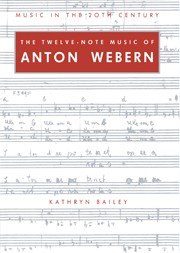Book contents
- Frontmatter
- Contents
- Acknowledgements
- Conventions in the text
- Introduction
- PART I Row and canon
- PART II The instrumental music
- PART III The music with voices
- Introduction to Part III
- 8 Das Augenlicht
- 9 Cantata I
- 10 Cantata II
- Conclusion
- Appendices
- Notes
- Glossary
- Chronological worklist
- Select bibliography
- Index
- Frontmatter
- Contents
- Acknowledgements
- Conventions in the text
- Introduction
- PART I Row and canon
- PART II The instrumental music
- PART III The music with voices
- Introduction to Part III
- 8 Das Augenlicht
- 9 Cantata I
- 10 Cantata II
- Conclusion
- Appendices
- Notes
- Glossary
- Chronological worklist
- Select bibliography
- Index
Summary
The six movements of Webern's last published work were conceived and written in two groups of three pieces each. The groups are very similar in outward design, each comprising an accompanied recitative for solo voice followed by an aria for the same voice and finally a movement for chorus and orchestra. Webern thought of each of these groups of three – perhaps especially the first composed – as a cohesive unit. The group that eventually became movements four, five and six was begun in the spring of 1941 and finished by September of the following year. The other group – movements one, two and three – was begun immediately thereafter and finished in November of 1943. A seventh movement was begun but soon abandoned as a part of the cantata, which Webern decided was complete as it stood.
‘Leichteste Bürden der Bäume’
On 13 August 1941 Webern wrote to the Humpliks:
By the same post I am sending you the first piece of my new work. It is ‘Der Wind’. However unassuming and simple–seeming the result, the constructive task I set myself was an extremely difficult one. With ‘the most delicate breath’ this should open the new ‘Cantata’ – or whatever it turns out to be. Formally, then, it is introductory, as the heading ‘Recitative’ implies. It is to be followed by ‘Freundselig ist das Wort’ – as a choral piece.
‘Leichteste Burden …’ (from the poem ‘Der Wind’) has the briefest text of all the movements: two lines of poetry that divide as the result of rhyming and punctuation into 8, 5 and 3, and 7, 2 and 5, syllables respectively.
- Type
- Chapter
- Information
- The Twelve-Note Music of Anton WebernOld Forms in a New Language, pp. 303 - 330Publisher: Cambridge University PressPrint publication year: 1991

